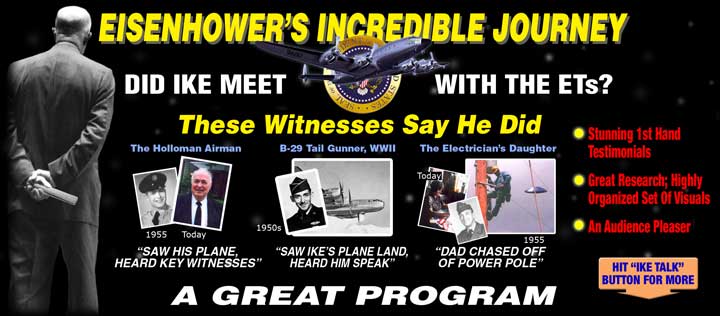
President Eisenhower at Holloman AFB?
On February 9, 1955, Eisenhower announced to the press that he was going to Georgia for a few days. He left on Feb. 10th at 1:00 p.m. from Andrews AFB with a party of six. A chartered planeload of journalists from all major networks accompanied him. The planeload of press was with Ike because of international tensions. The Russians were having a major leadership upheaval and the Red Chinese were making moves towards Formosa. Ike and party arrived at his destination, Thomasville GA, about 4:30 p.m. on Feb. 10th, hunted quail for an hour, and retired to his guest cottage. Less than 24 hours later, President Eisenhower showed up at Holloman AFB. Ike was out of the press view for some 36 hours. James Hagerty, his press secretary, told the press that Ike and his valet were "treating a case of the sniffles."
The source of Ike's visit to Holloman comes from an ex-airman stationed at the base hospital. The airman wrote a seven-page letter to UFO investigator/ speaker Art Campbell, delineating the details of Ike's visit and some of the activities while there. The Columbine III, Ike's Air Force One at the time, landed at Holloman around 9:00 a.m. on Feb. 11th. By previous arrangement, the plane taxied and parked on an active runway. A short time later a UFO was seen to land in front of Air Force One. A man presumed to be Ike left the parked plane and walked to the UFO. A meeting of some 45 minutes took place and then he returned to the plane. Another UFO was seen hovering over the flight line while the meeting was going on.
The details are sketchy, but Ike was at the base until 4:30 or 5:00 p.m. when his plane left. Hundreds saw it (photo above.) Ike and the base commander spoke to several hundred military and civilian workers on the base and at a hangar and in the base theater. The airman listed the names of eight witnesses to this event. Other witnesses are being sought by investigator Art Campbell.![]()
Part 1
A Trip To Thomasville
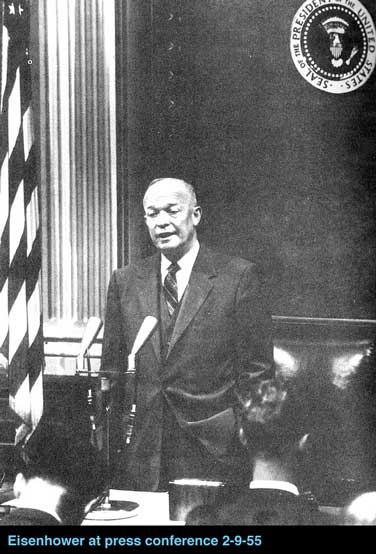 Washington, DC
Washington, DC
Executive Office Building,
Wed. morning, Feb. 9, 1955, 10:31 to 11:01 a.m.
In attendance 230 journalists
THE PRESIDENT: " Good morning. Please be seated. One announcement of little importance to anyone except myself. I hope to get a few hours away from this city starting tomorrow afternoon. I am going down with the Secretary of the Treasury to his farm in Georgia."
Eisenhower's Secretary of the Treasury was George H. Humphrey, a millionaire industrialist raised in Saginaw, Michigan. Humphrey owned a plantation near Thomasville, GA, where Ike hunted quail in February during most of his presidency. Thirty-five miles north of Thomasville was Spence AFB which had originally been a base for training for fighter pilots during WWII. It was an ideal place for the Columbine to land and only 35 miles to the Milestone plantation. Humphrey became Ike's secretary of the treasury. When Ike came down to Thomasville his motorcade would usually be accompanied by Georgia State police.
There were six in Ike's party, including Mrs. Eisenhower; her mother Mrs. Doud; Clifford Roberts, a Wall St. banker and advisor; and George Humphrey and his wife Pam. The party left the MATS terminal at Andrews AFB on Feb. 10 at 1:00 p.m. Ike's plane was a new Lockheed "Super Constellation", the VC-121 E. It had been christened by Mamie a year earlier and named the Columbine III after the Colorado state flower. Mamie was from a prominent Denver family and married Ike in 1916.
![]()
 The Columbine III, also known as Air Force One after 1959 or so, had a range of 3500 miles. The engines were four Curtis Wright R 3350, turbo compounds w/ 2700 hp each. Big for the day. Ike's plane had a wingspan of some 110 feet. The body of the Columbine was nearly 90 feet long and nine feet wide. The maximum speed was 355 mph with a cruising speed of 290 to 325 mph, depending on altitude. It carried a crew of fourteen, and Major William (Bill) Draper was the pilot. Draper had also been Ike's pilot in Europe during WWII.
The Columbine III, also known as Air Force One after 1959 or so, had a range of 3500 miles. The engines were four Curtis Wright R 3350, turbo compounds w/ 2700 hp each. Big for the day. Ike's plane had a wingspan of some 110 feet. The body of the Columbine was nearly 90 feet long and nine feet wide. The maximum speed was 355 mph with a cruising speed of 290 to 325 mph, depending on altitude. It carried a crew of fourteen, and Major William (Bill) Draper was the pilot. Draper had also been Ike's pilot in Europe during WWII.
It was an easy two and a half hour flight to Spence AFB in So. Georgia. The Thomasville Times -Enterprise papers of Thursday and Friday featured bold headlines: "Fair Weather Seen for Ike's Quail Hunt, Thousands Cheer His Arrival." The article went on to say "Thousands line streets in Moultrie, Coolidge and Thomasville." Spence AFB was just outside of Moultrie and people were lined up on the main street of the three towns that Ike would travel through. And even along the highway between towns. The paper reported that as the motorcade entered Thomasville, "the chief executive waved and spoke to persons along the route." Hundreds of students jammed along school campuses facing Jackson St. as the president entered Thomasville, the Times-Enquirer reported.
![]()
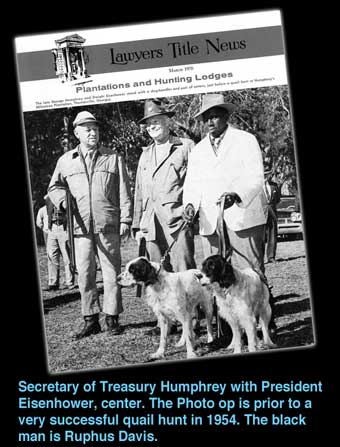
Milestone Plantation suited Ike's privacy needs very well. Here he was completely away from jangling telephones or weighty conferences. Humphrey's plantation had some 2,000 acres of prime bird hunting land. Ike had enjoyed hunting since his youth in Kansas. His favorite hunting piece was an 1897 Winchester repeating 16-gauge shotgun. On this occasion, he brought along his custom 20-gauge hunting piece. Specially made, it had custom carving on the stock: a wild turkey in flight on one side and his five general's stars in a circle on the other, with his name - Dwight David Eisenhower. Ike was a very good shot while hunting birds; however he found it hard to live down that in WW II, he had emptied a clip of nine 45 cal slugs shooting point blank at a rat in a latrine. The rat was soon dispatched when about a dozen aides came running after they heard the shooting. Ike was reported to have said, "I don't trust rats or Nazis."
In his 1954 trip to Milestone, Ike had bagged his limit every day he hunted. When ducks and quail were in season, Ike kept his skills sharpened with skeet shooting at his Gettysburg farm or at the newly-built Camp David outside of Washington DC.
![]()
 Except for previously arranged rare photo ops, none of the media were allowed on the Milestone grounds, but this time it was a little unusual. There was a great deal of international tension building. Accompanying Ike and his hunting party was James Hagerty, his press secretary who kept an eye on international events and kept the press informed as to the activities of Ike and his party.
Except for previously arranged rare photo ops, none of the media were allowed on the Milestone grounds, but this time it was a little unusual. There was a great deal of international tension building. Accompanying Ike and his hunting party was James Hagerty, his press secretary who kept an eye on international events and kept the press informed as to the activities of Ike and his party.
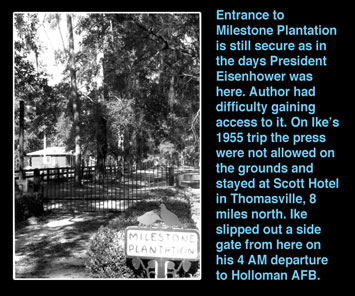
There was little to write about, but the Washington press corps did it well. A reporter from Newsweek wrote, "The president arrived at the estate just as dusk was falling. An old soldier, he took less than 15 minutes to change from his sack suit to hunting togs." Secretary Humphrey and Cliff Roberts took much more time. Ike was heard by his party to shout at his partners as they dressed, "We haven't got much daylight left." They reached the hunting area as dusk was falling about 5:30 pm.
Ed Darby who was on the press plane wrote for Time Magazine, "In spite of the wet brush, a cold wind and the gathering dusk, the president and the secretary of the treasury bagged two birds each." Darby's Times article was titled "Two in the Bag." They arrived back at the plantation main house after dark, somewhat cold, a little wet, but in good spirits. After dinner that night, Ike and the other men played bridge while Mrs. Humphrey, Mamie and her mother played Scrabble. Outside the rain drizzled and the mercury began to drop. The Newsweek reporter explained that "the dogs cannot pick up the scent" while the birds are huddled under cover in the wet brush. It looked like the predicted fair weather quail hunt had suddenly turned "foul."
Part 2
Two planes landed at Spence AFB north of Thomasville on Thursday, Feb. 10th. Preceding Ike's Air Force one was a chartered plane full of news media. They landed first, and, with various movie cameras, other journalists and technicians began setting up for Ike's arrival. Among them were well-known personalities representing 120 different news organizations -- Ray Sherer and Robert Blair of NBC, the well-known journalist William Lawrence of the New York Times, Walter Kingston of the Baltimore Sun and John Edwards of ABC as well as Ed Darby of Time Magazine. Others were also on the plane -- representatives from the AP and UP as well as a number of technicians for the Warner-Pathe News and a film crew from Metro Goldwyn Mayer.
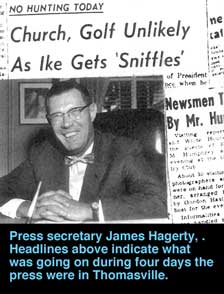
Why all of this high powered press for a quail shoot on private land and out of the press view? The headlines next to Ike's front page articles in the Times-Enquirer were very bold with an international flavor. A week before, Joseph Stalin's replacement Georgi Malenkov, the Russian premier had been forced to resign and was replaced by Marshal Bulganin. Headlines fairly screamed about the leadership change. Winston Churchill made immediate arrangements to talk to Marshal Bulganin. A famous military leader taking over an aggressive cold war government gave the world a severe case of the jitters. It was clear the Washington press corps wanted to be near the President.
Sometime in midmorning, James Hagerty dropped by the Scott Hotel where the journalists were staying with the hunting report. Ike and George Humphrey had gone out again that morning, but the birds were not active, so the hunters soon returned to their quarters empty-handed. To top it all off, it seemed that Ike had come down with a case of the "sniffles" and would be staying in for awhile. According to Hagerty, Ike was sitting by the fireplace playing bridge and chatting. It continued to rain on and off the rest of the day, but there was one bright note for the journalists -- Secretary Humphrey was throwing a dinner party for them that evening at the nearby Glen Arven Country Club.
Since their arrival the weather was taking a definite downturn, and many decided they needed some warmer clothing. As soon as the stores opened, the men fanned out in twos and threes to see what Thomasville was about. The Thomasville Cab Co. did a brisk business that day, taking the men to various stores and other places in the southern town. Hunters bright flannel shirts, sold well at Pennys. Just inside the front door was a manikin wearing a "short 'n sweet" nightie with Peek a boo panties, but many men bought heart shaped boxes of candy for the upcoming Valentine day occasion. That evening the Times -Inquirer talked about the cold wave, while on the funnies page Bumstead dreamed he was in a flying saucer.
It must have bee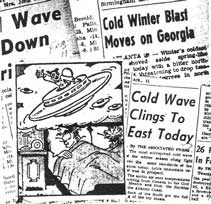 n reassuring to some that the leader of the free world in this time of world crisis was sitting by a warm fireplace nursing his cold, drinking hot toddies and playing bridge. Actually, this was not the case. At about 8:00 that Friday morning, Ike was not in his cottage. As the journalists and technicians were starting to stir and thinking about shaving, hot coffee and breakfast, their leader had taken a back road north to Spence AFB during the night and had skipped out. Air Force One was some 1250 miles away at 13,000 ft., somewhere above the west Texas/ New Mexico border, and Ike was not thinking about hot toddies and bridge. The President was on his way to Holloman AFB to one of the most important meetings of his life.
n reassuring to some that the leader of the free world in this time of world crisis was sitting by a warm fireplace nursing his cold, drinking hot toddies and playing bridge. Actually, this was not the case. At about 8:00 that Friday morning, Ike was not in his cottage. As the journalists and technicians were starting to stir and thinking about shaving, hot coffee and breakfast, their leader had taken a back road north to Spence AFB during the night and had skipped out. Air Force One was some 1250 miles away at 13,000 ft., somewhere above the west Texas/ New Mexico border, and Ike was not thinking about hot toddies and bridge. The President was on his way to Holloman AFB to one of the most important meetings of his life.
Ike and his advisors had been preparing material, collecting statistics and going over the rationale for continued nuclear testing. He, as the leader of the most powerful nation on earth, was also seen as the guardian or spokesman for the free world's nuclear arsenal. The arms race had began as soon as WW II was over and nuclear race was shifting in to high gear. The USA alone, up to 1955, had conducted 189 nuclear tests above ground, underground, under water and in the atmosphere.
The Russians had conducted some 90 nuclear tests since 1949 and had exploded their first hydrogen bomb in 1953. Ike was not sure how the meeting would go, but his advisors had prepared him as well as they could. He was very sure atomic energy would be at the top of the agenda. He and his few aides on board were informed by a crewman that they would begin the descent to Holloman soon. They buckled their seat belts and waited.
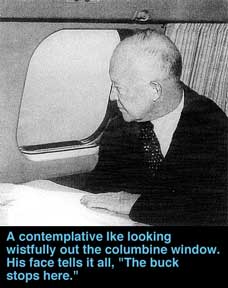
On one side of the huge plane could be seen the town of Alamogordo, and in the distance, the dual A shaped runways of Holloman AFB. As the Lockheed completed its final turn, to the west could be seen the San Andreas Mountains, and to the north, the long Tularosa Valley stretching into the distance. Above the white haze was a clear azure blue sky. It was going to be another beautiful day in New Mexico.
Part 3
Shortly after the US Air Force became a separate branch of the service, Alamogordo Air Base became Holloman AFB. It was named in honor of Colonel George V. Holloman, a pioneer in Air Force research and development. At one time in the early fifties, Holloman was a far-flung satellite of the Air Force Missile Test Center at Patrick AFB in Florida. In September of 1952 it was designated as a permanent Air Force installation.
The old Alamogordo airfield had been a training base for heavy bombers. The bombing range some 38 miles wide and 64 miles long, proved to be an ideal location for the new guided missile program which began in 1946-47. But that was fifteen years earlier. Today the president of the United States was landing at Holloman. It was a smooth landing as landings go. Dual tires on the concrete skid-marked runway felt rough at first. But after the wheels of the big Lockheed got up to speed, things smoothed out. Gradually the sagebrush came into focus, and the four powerful Wright engines took on the familiar sound of props under reduced power.
The big Lockheed Constellation in passenger service in those days carried over 125 passengers, but there were fewer than twenty aides and secret service men in the main cabin with the crew of fourteen each at his station. Some in a special compartment behind the cockpit, two in the small galley, and several in the aft passenger area. Each deep in his own thoughts, each glued to a window looking for something to break the monotony of the barren landscape. At about 7,000 feet into the landing, Major Bill Draper, the pilot, started reversing the engines, and the plane slowed measurably and became louder. When the noise died down, the plane was in a slow taxi towards the end of the runway. As the sleek Lockheed reached the turn-around at the end of the runway, Draper slowly put on the brakes of the left set of dual wheels, and the plane pivoted around to the port (left) side. Air Force One taxied back up the runway about 75 yds. and stopped. All engines were shut down.
There were probably 300 people with a vantage point on this side of the base, who saw Air Force One land, and as it did, they called others to other windows, work stations and vantage points. It must have seemed very eerie for the president's plane to be seen sitting out there almost a half mile away, alone and quiet. No red carpet, no band, no honor parade, just a few horned meadowlarks calling in the distance. Eventually, the base workers returned to their stations, typists resumed typing, stenographers turned on their dictaphones, phones rang and were answered. And always the question was asked: Is Ike here? What's going on? The civilians and military on the base had been told that while the president was here, this would be a "business as usual" day. It was hard, with so much excitement but everyone carried on.
A few minutes earlier, Col. Sharp, the base commander, and several officers had gone to the base ops tower to see the president's plane land. The first communication they heard about 8:10 was "HOLLOMAN TOWER, THIS IS AIR FORCE 7885 TEN MILES EAST OF MARYHILL." They requested landing instructions, other traffic in the area, and base wind direction. They were assigned runway 13 (short for 130 degrees.) The Holloman runways in those days formed a gigantic letter A, running northwest to southeast. The runway they were assigned was the farthest away from the hangars and workshops. It was obvious to base personnel that what was happening or going to happen was as far away as it could be. Little could be seen unless one had a vantage point and binoculars. Phones all over the base were very busy, many questions were asked, is he still out on the runway? What's he doing now? What's going on? What's happening? And the invariable answer: We don't know.
But about ten minutes after the plane landed, the radar officers gave instructions to shut off all radar controlled from a room under the control tower. The enlisted men had been told only about five minutes earlier about shut down. Col. Sharp could probably hear some of the men in the stairwell mumbling about the base being blind as the men headed outside to have a smoke. Technically, the colonel was on leave today. He had turned base operations over to his deputy base commander as long as the president was here. He felt it his duty to be with him with no distractions.
There were a dozen visual patrols out around the base and some of the up-range small radars were on, but the larger base Dopplar radar had been shut down by orders from Washington. A phone rang in the tower with a report of two unidentified objects passing over Range Road 12. Then a minute later the bogies were over Range Road 7 only a few minutes from the runways. Men in the tower swung their glasses to the north in the morning haze. Then something glinted in the sun, then something else just below it. A report came in of a third bogie five minutes behind the first two. The tower personnel who did not know what these were, were stunned. No tail, no wings, no motors. Just round objects approaching the president's plane sitting alone on the far runway with a covey of base officers in the tower, including Col. Sharp. They knew something big was up. They reported the objects, logged them and did their job which was "business as usual."
The two objects stopped about 300 ft. over Air Force One, and one descended on the far side of the plane and gently touched about 200 feet ahead of the plane. The other hovered briefly and then came across the near runway towards the big hangars and some shop buildings. It took up a position somewhere above the buildings over the tarmac. The disc had a good vantage point of anything that might come towards the president's plane and the disc on the ground.
A brief look at the public view of UFOs in 1955 would not cause any eyestrain. Only a few scattered newspaper reports since 1947 had made national news, and in those days the military were likely to be believed when they released cover stories. Kenneth Arnold had seen only reflections. Everyone got a chuckle at the Roswell balloon story, and the blips seen on radar and over the White House in July of 1952.....just sea gulls. Donald Keyhoe was just getting the NICAP idea started and several books by Scully and Adamski were considered just men's magazine sensationalism. So it was with some disbelief that two UFOs had come to Holloman AFB in Feb. of 1955. There was little background for believing in them at all as extraterrestrial. Some who saw or heard about the two craft at the base that day thought they might be new German innovations. Some thought they were ours others thought they might be Russian.
German scientists assigned to supervise missile launches in Operation Paperclip at the near by White Sands Proving Grounds were highly respected, and some German scientists were working in various labs at Holloman. "Business as usual" may have been the motto for the day, but many of those with a vantage point had someone reporting what could be seen. Soon after the UFO landed in front of Air Force One, a man many assumed to be the president, came to the doorway of the plane, descended the portable stairs and approached the saucer on the ground. Some sort of a hatch had been opened a few minutes before and had folded down to become a small ramp. The man walked up the ramp, stood briefly at the opening, shook hands with someone, and went inside. Observers thought the period of time to be about 45 minutes. When he emerged from the craft, he walked towards Air Force One. Part of this time he was facing the observers, and most were sure it was Ike. He wore no hat, and many recognized the hairline and his erect military walk.
PART V
Part 4
Our main witnesses were Airman 2nd Class Wilbur Kirklin (pseudonym) and his friend Dorsey Moore, who were stationed at the base hospital in 1955. Their only actual sighting that day was of Air Force One taking off about 4:45 p.m. on Feb. 11th, 1955. Kirklin reports as follows:
"In the spring of 1955 I was assigned to the Holloman AFB hospital. In February we heard that the president was coming to Holloman. It was general knowledge that there was going to be an honor parade for him. Captain Reiner asked me if I wanted to participate in the early morning parade. I declined and he said, OK, that I would be on duty that day. The day before it was to take place, it was called off. We believe the secret nature of the visit was probably not explained until several days before the president's arrival. When this word was received, the honor parade was then called off.
On or about Feb. 11 at 8:00 in the morning, Kirklin began his shift at the base hospital. Another airman named Dorsey was due to be there also. Kirklin said that when I got there the nurse asked me where Dorsey was. A clerk typist named Dorothea Thorenson replied that she had seen him taking his wife to the commissary (large base shopping area) that morning. When Dorsey finally arrived he asked me if I had seen the disc hovering over the flight line. I told him I hadn't, but I was visualizing something small you held in your hand like a track and field disc. I asked him what it was made of. Dorsey said it looked to him like polished stainless steel or aluminum. When I asked about its size, he said twenty - thirty feet in diameter, and did I want to see it. Of course I did. Dorsey said it was there when he took his wife to the commissary, and was still there when they came out thirty minutes later. "Go out in front of the hospital and look towards the hangars ," he said. I asked the nurse for permission. Nurse turns to doctor, then says, "No. Stay here." (probably about 9 - 9:15 a.m.)
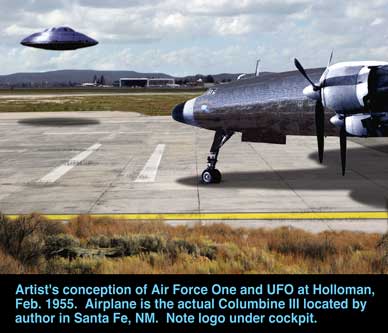 Author: From several sources, we have learned that the base department heads had been asked to keep normal activities going that day. This may have been an attempt to comply with this "business as usual" mode during the president's visit. Another airman relates his experience on the way to coffee later that afternoon. He had been walking behind two officers. One officer was the duty OD. The one dressed in khakis asked the other officer why he was in his dress blues that day. The other officer explained that he was "officer of the day. I was at base ops (control tower) when Air Force One came in this morning. As soon as it landed we shut down the radar."
Author: From several sources, we have learned that the base department heads had been asked to keep normal activities going that day. This may have been an attempt to comply with this "business as usual" mode during the president's visit. Another airman relates his experience on the way to coffee later that afternoon. He had been walking behind two officers. One officer was the duty OD. The one dressed in khakis asked the other officer why he was in his dress blues that day. The other officer explained that he was "officer of the day. I was at base ops (control tower) when Air Force One came in this morning. As soon as it landed we shut down the radar."
The first officer asked why they would turn off the radar and learned that they were ordered to from higher up. We think the Doppler radar may interfere with the saucer's guidance system.....or something. Both came in over the president's plane. One landed on the active, and the other hovered for awhile, then moved over to the flight line. (This one was apparently seen by Airman Dorsey and an electrician earlier in the day.) The president left his plane............... and went towards it. A door opened, a ramp came down and he went inside for 45 minutes. The first officer asked who all saw this; the other officer said, the personnel in the base ops control tower as they had binoculars. When asked if anyone saw who was inside the saucer, the officer replied, "No, it was faced pretty much away from the tower at a sort of oblique angle."
It would be appropriate here to bring in a rather interesting report received from a lady whose father was a civilian electrician at the Holloman base. He worked out during the day on the base with the electrical crew, out of the base electrical shop. He had been an electrician in the army in Korea and had gotten the job in 1953 or 1954 because he was a vet. She said, "We were in Albuquerque at the time. Dad worked there in '54 and came home on weekends. We moved down there in the summer of '54 when I was in the fourth grade. Mom wanted us together. Sometime after Christmas of 1955 Dad came home one night kind of shook up. He would tell the story for years when we'd ask him to, and later on, to the grandchildren as well. We called it 'When Dad became a fireman.' I asked the daughter if the story got better with the telling each time. She said no, but as he got older, we enjoyed it more because of his gestures.
They worked out of a 3/4 pickup with a telephone co. truck bed (lots of compartments.) Dad told us " They could see the president's plane for most of the landing. At first it circled, getting lined up for the runway. We had a view of the runway between some buildings where we were working. They could see about 400 to 500 feet of it. The plane landed, came through the part they could see . They expected to hear it taxi up to unload , they all wanted to see the president. He they waited and waited . It just stayed out there someplace and shut down its engines. They saw others looking out that way, and some men on the roof of a hangar looking to the SE. One of the crew suggested that someone climb a pole to report what was going on, so Dad volunteered. He strapped on his steel climbers. Dad said he had learned to always keep the sun at his back while climbing a pole in order not to get blinded. Dad said he got near the top of the pole and head someone shout, but did not hear the words. He then saw the truck driving off and some of the crew running toward a hangar. He noticed the men on the roof running back away from the front of the hangar, and one pointing out towards the flight line. Dad swung around on the pole to look out on the airfield and see what all the commotion was about. Then he said he saw it...this "pie tin like thing" heading towards him about 150 yards away. "And comin' right at me," he said. Dad always said he felt very lonely up there with that thing, and decided to come down fast,as he was about 40 feet up. He said he looped his climbing strap out and got down that 40 feet in about five seconds, his steel spikes hitting only occasionally to slow him down."
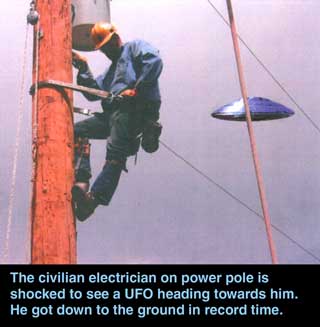
Back at the shop when the story was told, he was nicknamed "the fireman" for getting down that pole so fast. Apparently, soon after this incident, the saucer just stopped and hovered about 300 feet over the flight line while the meeting took place on the far runway near the UFO. Dad said once the people there got over the initial shock, many just stood and watched it. He said it was a beautiful sight, and it had an occasional wobble. He recalled that later that day many neon lights needed replacing. (Author: This was apparently the saucer that hovered over the flight line that Dorsey and his wife saw around 8:45-9:00 a.m.) His daughter said they all thought it was one of our secret aircraft and the president had come to see. Dad said he never considered it anything but ours until years later when the UFO shape got publicized more (in the 1960s or so). He told us" it was then that he understood what was so secret".
Part 5
In the previous issues we have followed President Eisenhower from a hunting trip in Thomasville, GA, to a secret departure from Spence AFB to Holloman AFB in NM. The president was supposedly in his cottage for 36 hours at Milestone Plantation, when he slipped out for his trip west. By previous arrangement, his plane parked at the end of the runway, a UFO landed in front of the plane, and the president went aboard for a 45-minute meeting. Another UFO was seen by base personnel hovering over the Holloman AFB flight line during the duration of the meeting.
Our main witness, Airman Kirklin on or about Feb. 11, 1955 was on duty at the base hospital. He continues the events as he experienced them from this date. Airman Kirklin returned from lunch about 12:50 p.m., Dorothea the civilian typist and the nurse asked him if if he had seen Dorsey. "I said I hadn't. At 2:30 p..m., coffee break time, I walked down the hall and saw Dorsey coming in. I asked where he had been. He replied, at a meeting. I told him to tell the nurse and Dorothea that I was headed for coffee. After supper I noticed the lights still on in the flight surgeon's office and went over to turn them off. Surprisingly, Dr. Reiner was there and was talking to a Lt. Colonel. The Lt Colonel was telling him that he had heard the president and Col. Sharp speaking to about 225 people at the supply hangar." He said there were military personnel and civilian workers including a few female office workers. Dr.Reiner wanted to know what the president said.
The Lt. Colonel said that he just gave them a pep talk and said to keep up the good work, etc. He only spoke five minutes or so, and then Col. Sharp spoke for another twenty minutes or so. His speech included warnings such as, "What you see here stays here" and something about the "fine security traditions", etc. at the base. Dr. Reiner's friend also said the commander-in-chief and Col. Sharp spoke once or twice more at the base theater which held over 200 people. Apparently, Ike told each group that he wasn't supposed to be there that day. Kirklin reported to the author, "If the president of the United States did not know where he was supposed to be, how could we?"
The author believes that there was considerable pressure on the Holloman base personnel in the short run, not to let it the president's visit be known. This secrecy was probably aimed at the press in Thomasville as well as the national press, so that Ike would not receive embarrassing questions later or when he got back to Thomasville ,the next day The ruse worked, as there was not a hint of Eisenhower being away from his cottage in Thomasville in the 36 hours he was away from the journalists' view.
It is more than likely that this meeting at Holloman AFB was not Ike's first visit with the ETs. The meeting was too short. It is possible that there were some negotiations going on and that something had to be clarified that took just a little time. There is some circumstantial evidence that President Eisenhower met the ETs at MUROC (later Edwards AFB) a year before. The press said, "Ike went missing for a few hours" which would give him the opportunity to meet with or see ET craft or dead bodies which were believed to be at Edwards in Feb. of 1954.
Grant Cameron, a Canadian UFO researcher and expert on presidential associations with UFOs, told the author that there was an entourage of some 250 people with Ike the year before at Muroc. It is thought that to simplify things, Ike slipped away from the press at Thomasville, this time with the immediate goal of keeping the press off his trail. The second consideration might have been to keep other countries, including the Russians and the Communist block out of the loop in regard to the rendezvous with the UFO at Holloman.
Why Holloman? It was remote, it was secure, and above all, it was away from the press. Apparently, the Holloman secret from 1955 did not begin to be revealed until forty years later, six years after the Soviet Union collapsed. To the author's knowledge, Kirklin is the first to bring this story out, naming witnesses. To be sure, the story has blanks, but most good plausible stories do. All that can be expected of anyone is that they simply tell with honesty what they know, heard, and saw. Kirklin has done this, and his story checks out. I asked him once why he had come forward. He replied that the main reason he shared his recollections and memories was that he was tired of government secrecy. He said that if he hadn't shared it, he would be part of the cover-up. Kirklin is now a retired inspector for the US Dept. of Agriculture, living in the midwest.
Kirklin related one other story about when Ike left the base. This was to be Kirklin's only actual sighting that day. The balance of what is written here was what had been told him by others. Kirklin's words are as follows:
"After work I was in my barracks room when I was called out to see Air Force One fly overhead. It flew over the residential area of the base. This is a NO FLYING zone for all military aircraft. Only the President could get away with it."
Saturday morning Feb. 12th
After five hrs. or so of flying, We believe Ike's plane landed back at Spence AFB near Moultrie Ga. By 1 AM or so Ike was back in his cottage. He had one planned activity this day, he was going to autograph a photo for some Georgia State Policeman in Thomasville. Some of the newsmen thought he looked a little tired. After the autograph signing it was back to Milestone and seclusion and probably some much needed rest.
Sunday Feb. 13th
Ike had a full schedule in and around Thomasville this Sunday starting about 11PM. His party motored to the Greenwood Plantation for lunch and had a photo op near the famous Big Oak in Thomasville. Then his party drove 35 miles north where the big Air Force One was warming up. Ike and his party left from Spence about 3 PM for Washington DC. The next day was special for the Eisenhowers; it was the 39th anniversary of their engagement, in 1916. After his return to Washington, Ike's appointment schedule listed three important people: Admiral A. W. Radford, Chmn. of the Joint Chiefs of Staff; C. Irwin Wilson, Sec'y. of Defense; and John Foster Dulles, Sec'y. of State.
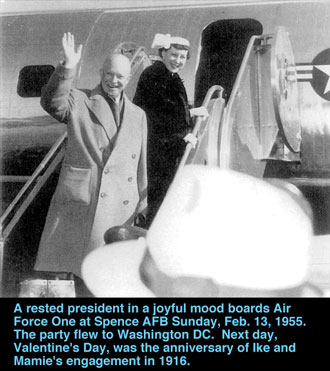
As the author looks back, Dwight Eisenhower, the 34th president of the United States, was probably the best president we could have had at that time. He was decisive, highly respected, and an excellent leader. He was much admired overseas while serving as the supreme commander of NATO. It is thought that his administration had dealings with and a dialogue with beings from other planets, a presidential first. With our system of government, however, he was not able to exert as much influence over government policy and direction that some thought he might have.
In some correspondence from the United Kingdom, a man who had access to super secret MI5 archives, wrote to the author, "In the 1953-1955 timeline, the ET visitors had landed at several places and asked for a meeting with the leader of the most powerful country on earth." He believed that the meeting at Holloman was one of the first meetings with that race of aliens. (He thinks there were two or three separate alien groups in all that met with the Eisenhower administration during his presidency.) This source said that, "the top item on the meeting agendas was continued nuclear research and testing with more and more powerful weapons." The MI5 source alluded to a Russian nuclear bomb test in September of 1951 that was half the size of the first 1949 bomb with twice the power. He said, "the visitors showed great concern over our hydrogen bomb detonation 1952." (Nov. 1, 1952 at Eniwetok atoll, 500 times more powerful than the Hiroshima bomb.) UFO sightings dramatically increased over military/ nuclear facilities and later launch sites for well over three decades.

The MI5 source indicated that there was considerable pressure on President Eisenhower to exert some influence over his government's accelerated nuclear testing programs. Apparently, those in government who knew of the alien concerns decided to form a committee to advise the President concerning these matters. He believes this group was initially called the alternative committee. Might this have been the beginnings of the group that, today, is believed to be the extremely powerful worldwide special interest entity which exerts considerable influence on UFO secrecy? It is obvious to this writer that our Government is not merely covering up whether UFOs exist but that we have had contact with ETs and they have objected strenuously to our nuclear testing, stockpiles arms race.
All of these pressures on Pres. Eisenhower few knew about at the time. The entire world was shocked, but probably not surprised, when Pres. Eisenhower had his first heart attack in September 1955, in Denver, Colorado. He convalesced there in a civilian hospital for six weeks before returning to Washington and a reduced schedule. His domestic difficulties were, however, just beginning, when that Dec. in Montgomery, AL, a tired domestic worker named Rosa Parks refused to give up her seat on a bus to a white man. The resulting boycott lasted some 54 weeks. Ike recovered from his heart trouble and ran for a second term and won, in 1956. He weathered the Little Rock crisis, saw the Soviets send up Sputnik in 1957, he supported the formation of NASA in 1958, and he saw the first US satellite, the Explorer, launched earlier that year.
On Jan. 17, 1961, Eisenhower gave his farewell address in which he warned of the growing power of the "military/ industrial complex." Ike returned to his Gettysburg farm for the remainder of his retirement, but he again cautioned that, "long continued military expenditures could breed potential dangers to our way of life." After a long illness, the 34th president of the United States died on March 28, 1969. Mamie joined him a decade later, in 1979. Both are interred in the Eisenhower Library site in Abilene, Kansas.
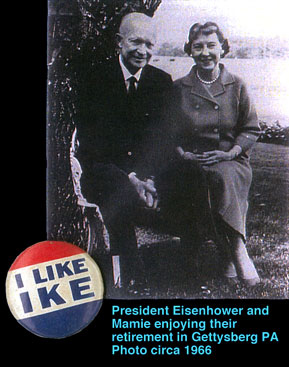
The author would like to hear from you if you were on the base in 1955 or living in or near Alomorgodo. Was there any talk at the grade school or high school? Did anyone see or hear Air Force One that day? Do any parents recall being at the base that day? Please contact Art Campbell. E-mail artc@connpoint.net
![]()
Part 6
Passenger Manifest, Godfrey, Murrow And The Secret Service
Late in the Eisenhower/ Holloman research, the author received a list of the crew and passengers on the trip to Moultrie/Spence AB and Thomasville, Georgia. The crew was a full complement of fourteen, including four guards who rotated shifts while the plane was on the ground. Going down the list, besides the President and First Lady and their party of six, were such people as one might expect. There was Mamie's personal maid, Eisenhower's personal driver, Jim Hagerty (Ike's press secretary) Hagerty's secretary, and Ike's valet, etc. One name jumped off the list -- that of Arthur Godfrey. I checked to see if this was the famous Godfrey of 1950s TV and radio fame, and sure enough, it was. He was not listed as a social guest as announced in Eisenhower's papers, nor was his name listed in any activities at Milestone Plantation.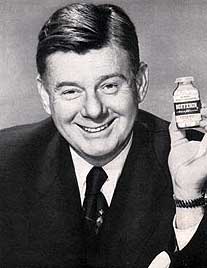
What was Arthur Godfrey doing on the president's plane? The Godfrey TV shows helped define at least the first decade of 1950s television and radio. Godfrey was associated with his weekly Talent Scout and Arthur Godfrey and his Friends, both variety shows on CBS TV. Both shows were watched by millions and finished in the top ten for most every year in the 1950s. However, Godfrey's star faded somewhat in the late 1950s as his human interest variety shows gave way to action and comedy shows beginning to made in Hollywood. But in February of 1955, his shows and his persona were very high on the TV producers' and viewers' lists.
Godfrey was a rather kindly, freckled-faced grandfatherly type with a folksy Will Rogers-type persona and delivery. He was very calming, as he introduced his clean-cut singers and guest stars. He was a skilled host and pitchman. He was credited with introducing such up-and-coming stars as Julius LaRosa, the McGuire Sisters, Pat Boone and a very popular group in those days, called the Toppers. He was TV's first super salesman. The Museum of Broadcast Communications said, "He only sold from the heart." His sales pitches sounded like "he was confiding in you alone. Godfrey's rich warm resonant descriptions of products he had personally tried caused many to go out and purchase what he endorsed." He also played the ukulele on occasion, and sang for his audience.
What was the one and only indomitable Arthur Godfrey doing on the president's plane? Was he there to do a monologue, play his uke and do a soft shoe in the aisle? He was not seated with Ike or his social guests in the main passenger compartment, but was in the forward crew compartment with about a dozen others, including the flight crew and some secret service agents. It is believed Godfrey had boarded the plane earlier before it had taxied to the main MATS terminal to pick up Ike and his guests. Ike's guests were probably not aware that he was on the plane. According to news sources including Time Magazine and other sources later confirmed, Arthur Godfrey and Edward R. Murrow were part of a huge civil defense effort to assist the government in making pre-recorded taped messages to be sent on TV and radio airwaves in case of nuclear attack.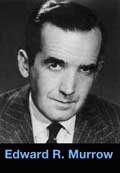
Ted Gup wrote in a Time Magazine cover story (Aug. 10, 1992, p.32-38) that throughout the Eisenhower administration, and for years after, a vault held tape-recorded addresses by both Eisenhower and celebrities Arthur Godfrey and Murrow. The pre-recorded message was concise: " The country has come under nuclear attack, but the government continues to function." Gup said in his Time article that a number of newsmen had taken oaths of secrecy and had agreed to accompany the president to the relocation site of his choosing to lend their familiar names and voices to help calm the surviving audience. Recalling the separate press plane that accompanied Eisenhower to Spence AB and Thomasville, one wonders if any of these spokesmen were also along on this strange trip ? What was going on here? Was this trip a true potential national emergency ? or another trial run of apparently many in those days ? There were a number of facilities in the mid 50s, where government entities could relocate to in case of national emergency. One was 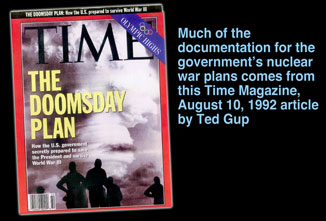 an underground bunker named Mt. Weather near Godfrey's home in Beryville, Va. and another facility named Raven Rock near Gettysburg, Pa., where Eisenhower and his cabinet convened on a number of "practice occasions." There were also other sites prepared in case of emergency for almost all important branches of government. Another person or two on the passenger list who may have been involved in what Time called The Doomsday Plan, was Joseph Giordano, a radio producer; and another man Robert Lennon whom we can find little about.
an underground bunker named Mt. Weather near Godfrey's home in Beryville, Va. and another facility named Raven Rock near Gettysburg, Pa., where Eisenhower and his cabinet convened on a number of "practice occasions." There were also other sites prepared in case of emergency for almost all important branches of government. Another person or two on the passenger list who may have been involved in what Time called The Doomsday Plan, was Joseph Giordano, a radio producer; and another man Robert Lennon whom we can find little about.
.
In retrospect, the Quemoy, Matsu international crisis did not seem, at the time, to be particularly serious. My (later to be) wife and I were experiencing a budding romance at a Junior College. A year before, I had been discharged from the US Navy and I was just getting my civilian college plans under way and preparing to enter Michigan State University the following fall. Apparently, there was some very serious rhetoric directed at the Red Chinese the Russians and east block countries by our government. The previous fall the Red Chinese had begun shelling some Nationalist Chinese strongholds in the Tachen Islands, including Quemoy and Matsu. Many thought an invasion of the islands was imminent that spring of 1955. To those readers who were not around in those days the Red Chinese, (in 1946-49) under their dynamic leader Mao Tse-tung had pushed our wartime ally Chiang Kai- shek and his forces off of mainland China. Chang had retreated to some offshore islands with about 130,000 military men and over 900,000 civilions.
 Alluded to earlier in this story was the Formosa Resolution passed overwhelmingly in both the Senate and the House (Senate 85 to 3, and House 409 to 3.) In essence, Congress had authorized "war in advance" at a time and place of President Eisenhower's choice. John Foster Dulles, Ike's Secretary of State, talked about "new and powerful weapons of precision." Dulles said later that the US was prepared to use "tactical" atomic weapons to defend Formosa. In a press conference a few days earlier, Eisenhower inflamed the debate when he said about nuclear weapons, "These things can be used on strictly military purposes. I see no reason why they shouldn't be used just exactly as you would use a bullet." This statement shocked many allies as it did Americans. As Ike and his hunting party left for Georgia on February 10th, the events of the last two weeks and our government's talk about nuc
Alluded to earlier in this story was the Formosa Resolution passed overwhelmingly in both the Senate and the House (Senate 85 to 3, and House 409 to 3.) In essence, Congress had authorized "war in advance" at a time and place of President Eisenhower's choice. John Foster Dulles, Ike's Secretary of State, talked about "new and powerful weapons of precision." Dulles said later that the US was prepared to use "tactical" atomic weapons to defend Formosa. In a press conference a few days earlier, Eisenhower inflamed the debate when he said about nuclear weapons, "These things can be used on strictly military purposes. I see no reason why they shouldn't be used just exactly as you would use a bullet." This statement shocked many allies as it did Americans. As Ike and his hunting party left for Georgia on February 10th, the events of the last two weeks and our government's talk about nuc lear weapons left considerable tension in the world. Admiral Radford, the chairman of the Joint Chiefs of Staff, said, "War can break out any time." Ike's calendar, the first day after he returned from Georgia (February 14th), showed him with both Admiral Radford and John Foster Dulles in consultation. Red Chinese shelling of Chiang's off shore islands in 1955 may seem today like a tempest in a teapot, but the international situation in early February of 1955 apparently warranted some contingency plans when the president traveled. A spokesman such as Arthur Godfrey may have been somewhat reassuring, at least to some. Congressional leader Lyndon Johnson helped push the Formosa Resolution through congress. Years later as president, he used the Formosa Resolution as a model for his Gulf of Tonkin Resolution to escalate the fighting with north Vietnam.
lear weapons left considerable tension in the world. Admiral Radford, the chairman of the Joint Chiefs of Staff, said, "War can break out any time." Ike's calendar, the first day after he returned from Georgia (February 14th), showed him with both Admiral Radford and John Foster Dulles in consultation. Red Chinese shelling of Chiang's off shore islands in 1955 may seem today like a tempest in a teapot, but the international situation in early February of 1955 apparently warranted some contingency plans when the president traveled. A spokesman such as Arthur Godfrey may have been somewhat reassuring, at least to some. Congressional leader Lyndon Johnson helped push the Formosa Resolution through congress. Years later as president, he used the Formosa Resolution as a model for his Gulf of Tonkin Resolution to escalate the fighting with north Vietnam.
 According to Frank Stanton in a 2004 interview, a group called The Eisenhower Ten, was a established during President Eisenhower's second term (1958-1961,) to serve in critical government roles, in the event of atomic attack or other disaster. If such an event had taken place Stanton (a Phd.) was to have served as administrator of what was known as the Emergency Communications Agency. That Arthur Godfrey and Edward R. Murrow made the recordings. "It's true," Stanton said, "absolutely true." Searches in various archives, however, have failed to locate the recordings. Stanton who died in 2006 and was a revered figure in American television. He knew Arthur Godfrey well and was credited with bringing Jackie Gleason into television.
According to Frank Stanton in a 2004 interview, a group called The Eisenhower Ten, was a established during President Eisenhower's second term (1958-1961,) to serve in critical government roles, in the event of atomic attack or other disaster. If such an event had taken place Stanton (a Phd.) was to have served as administrator of what was known as the Emergency Communications Agency. That Arthur Godfrey and Edward R. Murrow made the recordings. "It's true," Stanton said, "absolutely true." Searches in various archives, however, have failed to locate the recordings. Stanton who died in 2006 and was a revered figure in American television. He knew Arthur Godfrey well and was credited with bringing Jackie Gleason into television.
Secret Service
Of the eighteen passengers on the Columbine III that left Andrews AFB for Georgia on February 10th, 1955, well over half were secret service agents and supervisors. We also know that two or three secret service agents were on the press plane that preceded Ike's plane into Moultrie AB, twenty-five miles north of Thomasville. This would make a total of 12-13 agents for a simple hunting trip where only briefly (coming and going), would Ike be in the public view. Correspondence from two former secret service agents indicates that this many agents would not be excessive for an overseas conference or a summit meeting where many experts well-versed in foreign language would be necessary. It was unheard of, however, for a short domestic "recreational" trip where the president would have little or limited public exposure. The Humphrey plantation was off limits to reporters on this and subsequent trips while Ike was there and his exposure was limited to a few photo ops in and around Thomasville. Incidentally, one of the young secret service agents in the president's plane on Ike's visit to Thomasville was Roy Kellerman. He achieved quite a bit of publicity seven years later as the agent in charge of the secret service detail in Dallas TX, when President Kennedy was shot. Agent Kellerman was in the front seat of Kennedy's car.
In 2007 I interviewed one of the security guards on Eisenhower's Columbine III crew. I asked what the usual complement of secret agents was, and he replied, "Usually five or six", and if they were going to a new place where the president had not been, two agents would go ahead and make security arrangements, but five or six were usually in the plane. "They often sat with us in our section, and we knew most by their first names.
" Then he said ............. "I do recall one trip down to south 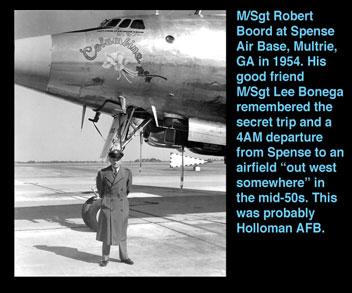 Georgia (he wasn't on this one) where there were a dozen or so going to this tiny little town." He went on to say that plane crew did not ask any questions, but they learned why the following day. About 3:00 a.m. they had gotten word that the president would be leaving in an hour. "We were always ready for this kind of thing, and sure enough, the plane left one hour later." He said about a half hour before the plane left, two Air Force cars pulled up and six agents came on board. They had apparently been booked into a nearby motel somewhere for a day or so. The other agents in the little town bustled around in their darkened vehicles, indicating that the president was there. No one noticed when the president returned late at night night a day or so later, and no one ever knew he had left.
Georgia (he wasn't on this one) where there were a dozen or so going to this tiny little town." He went on to say that plane crew did not ask any questions, but they learned why the following day. About 3:00 a.m. they had gotten word that the president would be leaving in an hour. "We were always ready for this kind of thing, and sure enough, the plane left one hour later." He said about a half hour before the plane left, two Air Force cars pulled up and six agents came on board. They had apparently been booked into a nearby motel somewhere for a day or so. The other agents in the little town bustled around in their darkened vehicles, indicating that the president was there. No one noticed when the president returned late at night night a day or so later, and no one ever knew he had left.
Author's note: This statement given in 2007 about an event 50 years earlier by a retired crew member/ guard is probably about as close as we will ever get to a verification of the Thomasville/ Holloman AFB story of 1955. The gentleman did not have any additional details, but his recollections of a dozen or so secret service agents on the plane matches the Air Force One leaving in the early a.m. for "somewhere in the west" story well. That many agents would be needed, especially if the president was appearing to be in one place but was actually "somewhere out west." The Feb 1955 supervisors and agents were: Jim Rowley, head of Eisenhower's Secret Service; Gerald Behn, head of White House Secret Service; John Campion, Head of Secret Service on specific trips; Agents John A. Walters, Secret Service linguist (spoke 6 languages); Agent Chavrins, Stewart and Stout. Also along were Agents Arnold Lau, William F. Shields, and Roy Kellerman. From press reports, we know of several other agents on the press plane.
Apparently, from Ike's known movements and activities according to reports of those who saw or heard him, he got his business over with the UFO by 9 a.m. or so. He spent the rest of the day with Base Commander Colonel Sharp looking at some facilities, having lunch, and speaking to several groups. It is felt by the author that both the president and Col. Sharp decided to allow some visibility as it would create more undesirable publicity to have him hidden, than in the public view where things would seem a little more normal.
We knew Ike was on the base from about 9:00 a.m. until about 4:45 p.m. when Airman Kirklin and his friends saw the president's plane take off. A 45-minute meeting time with the UFO occupants wold not lend itself to a meeting of much substance. The review of an item or two and one or two questions from either party might be accomplished in this short time period. However the 6-7 hour time frame (by the ETs or us), could have been time enough for some important information gathering or some additional consultation. "It was almost as if they were waiting for something and killing a lot of time," one civilian supervisor said. We know that in Feb of 1955 that The famous U-2 plane, was not operational yet. The major drawings were complete though, and the mockup was being tested in the Lockheed wind tunnel. The maiden flight was not until Aug 4,1955, later that summer. There, no doubt, were other intelligence sources available to the president and he might have been waiting on some of these. In any case, he left the Holloman base About 4: 45 p.m. Apparently, behind the pilot's compartment on Ike's plane there was a complete radar and radio room with state of the art communications gear including air to ground teletype and an air to ground telephone as well as scramblers and coding equipment.
Several curious facts emerge from the records of the Columbine III (AF 53-7885) that left Moultrie AB for Washington at 1:30 p.m. on Feb. 13th, 1955. Of the twenty-four in Ike's party that arrived in Moultrie (six in the social party and eighteen passengers), only 21 returned. Two were added; they were Mr. Jack Whitney and his wife Betsey who owned the Greenwood Plantation where Ike's party had lunched. Whitney later became the US Ambassador to Great Britain's Court of St. James. Two secret service agents did not return to Washington on Ike's plane, and conspicuously absent from the return list was Arthur Godfrey. If Ike had waited for some information at Holloman and it appeared that the smooth-talking, grandfatherly figures' services would not be needed, had he simply gone back to New York? We will probably never know.
Regarding the nuclear threats that President Eisenhower and John Foster Dulles issued to the world's two most powerful Communist countries just before the Thomasville trip, a reaction was soon forthcoming................. Nikita Khrushchef, in a letter to the White House, complained that, "In the USA there are still people who do not want to part with the policy and threats of atomic blackmail....." But Preident Eisenhower's warnings quelled the threat of a Chinese invasion. Over a half century later Taiwan (Formosa) prospers and still has not been invaded from the mainland. Dwight Eisenhower, as he had done in the Korean War, gave the American people what they most wanted. He drew a line in the sand, stood up, and kept the peace. Partially, as a result of the lessening of world tensions of the spring and summer of 1955, a summit of the Big Four (Russia, UK, France and the US) was convened in Geneva that July. Also invited were other free world nations and those from the communist block, including the Peoples Republic of China. It was hoped by the US and other democratic nations that this summit might lead to disarmament. Although the conference did not lead to immediate world peace, it did start a dialogue which eventually led to the downsizing of nuclear arsenals and future conferences. It also led to the realization that Nikita Kruschev was the rising power in Russia's leadership. At the conference, President Eisenhower gained recognition more firmly as a force for peace and disarmament. Journalists at the time called the open dialogue "the spirit of Geneva" and, for a brief time, the world seemed friendlier and less war-like, and a little more hopeful.
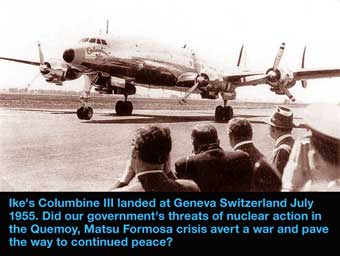
Footnotes:
The Museum of Broadcast Communications.
The Thomasville Times -Enquirer 2-10 to 13,1955
Time Magazine Aug 10, 1992
Pocock, U-2 Spy Plane, Schiffer Publications. 2002
Community Emergency Plan, Office of Emergency Services, State of California, 1961
Conelrad, www.Conelrad.com
Bibliography sources:
President's news conference Feb. 9, 1955, American Reference Library, Ebsco host research data base
Newsweek, Feb. 21, 1955
Time Magazine, Feb. 21, 1955
The Thomasville Times - Enterprise, Feb. 10 and Feb. 11, 1955
Dwight D. Eisenhower Library - Abelene, KS
Stephen Bassett, Paradigm Research Group





